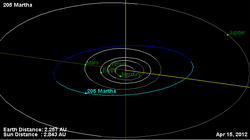Astronomy:205 Martha
From HandWiki
Short description: Main-belt asteroid
 Orbital diagram | |
| Discovery | |
|---|---|
| Discovered by | Johann Palisa |
| Discovery date | 13 October 1879 |
| Designations | |
| (205) Martha | |
| Pronunciation | /ˈmɑːrθə/[1] |
| Named after | Martha of Bethany |
| A879 TB | |
| Minor planet category | Main belt |
| Orbital characteristics[2] | |
| Epoch 31 July 2016 (JD 2457600.5) | |
| Uncertainty parameter 0 | |
| Observation arc | 136.51 yr (49860 d) |
| |{{{apsis}}}|helion}} | 2.8758 astronomical unit|AU (430.21 Gm) |
| |{{{apsis}}}|helion}} | 2.6783 AU (400.67 Gm) |
| 2.7771 AU (415.45 Gm) | |
| Eccentricity | 0.035571 |
| Orbital period | 4.63 yr (1690.3 d) |
| Average Orbital speed | 17.87 km/s |
| Mean anomaly | 198.37° |
| Mean motion | 0° 12m 46.692s / day |
| Inclination | 10.696° |
| Longitude of ascending node | 211.792° |
| 177.281° | |
| Physical characteristics | |
| Dimensions | 80.58±1.4 km |
| Rotation period | 14.911 h (0.6213 d) |
| Geometric albedo | 0.0553±0.002 |
| C | |
| Absolute magnitude (H) | 9.23 |
Martha (minor planet designation: 205 Martha) is a large main belt asteroid. It is a dark, primitive carbonaceous C-type asteroid. This object was discovered by Johann Palisa on 13 October 1879, in Pola and was named after Martha, a woman in the New Testament.
Efforts to determine the rotation period for this asteroid have produced wildly different results, in large part because the actual period is close to half of an Earth day. A study performed during 2013 showed that the light curve changed significantly during the observation period, adding to the difficulty. This study gave a synodic rotation period of 14.905 ± 0.001 h.[3]
References
- ↑ Noah Webster (1884) A Practical Dictionary of the English Language
- ↑ "205 Martha". JPL Small-Body Database. NASA/Jet Propulsion Laboratory. https://ssd.jpl.nasa.gov/sbdb.cgi?sstr=205;cad=1.
- ↑ Hawkins, Scot; Ditteon, Richard (January 2014), "Asteroid Lightcurve Analysis at the Oakley Observatory - May 2007", Minor Planet Bulletin 41 (1): 47–49, Bibcode: 2014MPBu...41...47P.
External links
- Lightcurve plot of 205 Martha, Palmer Divide Observatory, B. D. Warner (2010)
- Asteroid Lightcurve Database (LCDB), query form (info )
- Dictionary of Minor Planet Names, Google books
- Asteroids and comets rotation curves, CdR – Observatoire de Genève, Raoul Behrend
- Discovery Circumstances: Numbered Minor Planets (1)-(5000) – Minor Planet Center
- 205 Martha at AstDyS-2, Asteroids—Dynamic Site
- 205 Martha at the JPL Small-Body Database
 |

